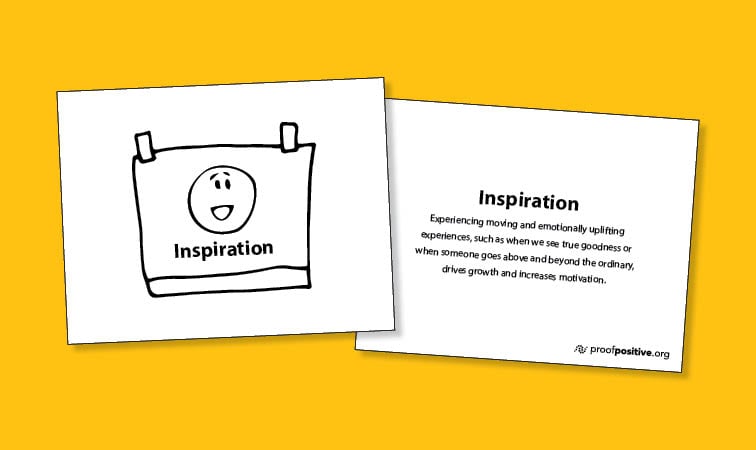About This Lesson
Happiness is typically the one word we use to describe feeling satisfied or enjoyment in what we’re doing. There are actually 10 different words to describe that enjoyable feeling, called the 10 Big Positive Emotions: awe, inspiration, pride, interest, serenity, love, gratitude, hope, joy, and amusement.
This International Day of Happiness (March 20) flashcard activity is designed to help students identify the 10 different positive emotions that contribute to happiness and prompt discovery about creating happiness in their daily lives.
Flashcard Instructions:
1. Print each sheet.
2. Cut in half longways along the dotted line.
3. Fold each card so the art and title show on one side and the definition shows on the other side.
4. Staple or glue folded sides together.
5. Practice knowing the 10 Positive Emotions.
Here’s what you’ll get:
- 10 premade flashcards with emotions on one side and the definition of the positive emotion on the other side
- Instructions on how to cut and fold the cards
- Access to a bundle of activities for the International Day of Happiness
Why you’ll love these sorting cards:
- The activity is easy to print and customize in your classroom or at home
- You can use this resource as part of a comprehensive, science-based unit study.
- The associated free unit study for Jolts of Joy comes with activities, downloadable worksheets, and even IEP and BIP recommendations tailored specifically to students with autism
- Encourages emotional literacy and growth in social-emotional learning (SEL)
- Helps students and educators celebrate the International Day of Happiness
Ways to Use
- Incorporate into SEL curriculum
- Integrate into small groups and/or individual counseling sessions
- Use as a brain break to help with transitions
- Families can use this at home, too!
What are Positive Emotions?
There’s more to feeling good than just happiness. Let’s start learning and teaching a variety of ways to describe the good feelings and emotions we experience day to day. Research identifies 10 Big Positive Emotions, each with many benefits. Pride, gratitude, joy, love, amusement, inspiration, awe, interest, serenity, and hope are all positive emotions.
Feeling a frequent healthy dose of each of the positive emotions is critical to the human experience. It helps us develop the mental, physical, and social resources we need to thrive and flourish.
In fact, it’s positive emotions that help us create the resources we need, like connections to one another, creative thinking, or problem-solving skills, to not only thrive but be resilient in times of adversity.
In her groundbreaking work on positive emotions, Dr. Barbara Frederickson introduces us to the extensive benefits of feeling good, described by the Broaden and Build Theory of positive emotions. Her findings demonstrate that when individuals experience positive emotions, their awareness broadens. Broadening means experiencing positive emotions quite literally opens your mind, you think more creatively, solve problems faster, and experience an expansion in your thoughts, vision, and actions.
Over time, these moments of feeling good enable you to build critical resources physically, mentally, and socially. Positive emotions experienced frequently and deeply support thriving and flourishing. That’s why we want to intentionally seek more experiences of positive emotions!
Science of Positive Emotions
Positive emotions create opportunities for growth and healing, mentally and physically. The Broaden and Build theory is based on the notion that positive emotions enable us to develop new and creative ways of thinking to enhance wellbeing and promote resilience. Scientific evidence finds that even little moments of joy throughout the day add up to greater physical and mental wellbeing. People who experience positive emotions think better, perform better, and feel better. Experiencing positive emotions regularly can:
- Open our eyes and minds
- Increase creative thinking
- Expand our visual field
- Allow for global thinking and diversity
- Prevent depression and anxiety
- Undoing effect
- Improve cardiac functioning
- Increase healthy sleep
Learn more about the science of happiness and positive emotions
Looking for more Positive Emotions resources?
- Explore the free Jolts of Joy Unit Study, which comes with teaching slides, additional worksheets and activities, and even IEP and BIP recommendations tailored specifically to students with autism.
Proof Positive's resources are and will always be free. Be well!
Bonus access to full lesson plans and unit studies on the skills of happiness at our Skill Center













